Breast cancer : types and treatments
Oct 11th, 2022, by Labtoo's team
Every year, up to 500 000 women die from breast cancer. "In October we wear pink" at Labtoo to support and raise awareness around us about breast cancer.
How does breast cancer work?
Breast cancer occurs when the cells, located in the breast, duplicate uncontrollably. At first, they remain confined and there are no apparent symptoms. At this stage the threat is minimal. But, over time, the cells will proliferate and spread onto the surrounding tissues. If the tumor is left unattended, it will lead to the patient’s death.
What are the different types?
There are several types of breast cancer, depending on which cells are concerned and the extent of their proliferation:
Invasive Ductal Carcinoma (IDC)
At this point, the cancer cells spread beyond the ducts into other parts of the breast tissue. It is a matter of time before they reach different parts of the body like the brain, the liver, or the stomach. IDC makes up for 80% of all the diagnoses of all breast cancer and is the breast cancer that most men are affected by.
Ductal Carcinoma In Situ (DCIS)
Non-invasive cancer affecting the milk duct cells, commonly diagnosed in women. The cancer is at an early stage which increases its treatability. the tumor is local and small.
Lobular Carcinoma In Situ (LCIS)
Uncommon condition in which the cancer cells start forming in the lobules. Even though LCIS is not a type of cancer itself, being diagnosed with it indicates an increased risk of developing breast cancer.
Invasive Lobular Cancer (ILC)
Once the cancer cells start expanding toward other tissues, the threat becomes serious, especially if other organs are exposed.
Triple-negative Breast cancer
In this case, the abnormal cells have tested negative for all three most common receptors, known to fuel the growth of the tumor (HER-2, ER, PR). So common treatments like hormone therapy and drugs targeting those receptors are pointless. However, chemotherapy is proven to be an effective option. But this type of cancer remains aggressive and complicated to treat, likely to recur.
Inflammatory breast cancer (IBC)
Classified as stage 3 breast cancer, this aggressive and fast-growing cancer infiltrates the skin and lymph vessels of the breast. It’s only once the lymph vessels are blocked that symptoms arise. Prior to that no lump or tumor can be felt.
Metastatic breast cancer
Considered a stage 4 cancer, this type is characterized by the spreading of the disease to other tissues or organs. Consequently, new tumors (micrometastases) form in different locations.
Who is at risk?
Breast cancer is not a transmissible or infectious disease. It has been established that 50% of breast cancers develop in women over 40 years old, demonstrating a strong age incidence. Factors like hormonal and genetic (family history of breast cancer) also impact strongly the development of tumorous tissues in the breast. Additionally, external factors are known to increase the potential risk, like obesity, alcohol, radiation exposure, and tobacco.

What are the treatments?
Nowadays, breast cancer can be cured efficiently with high success chance. The treatment consists of surgical removal of the lump, combined with radiation therapy and medication, at an early stage of cancer.
Lumpectomy: Removal of the palpable lump as well as the nearby lymph nodes. Quick procedure, for small tumor extraction.
Mastectomy: Removal of the entire breast and the surrounding lymph nodes. A common procedure for stage 4 breast cancers.
Radiation therapy: Generally used after a lumpectomy, it aims at destroying the remaining cancer cells by exposing the breast to high-energy radiation. This treatment is most effective against stage 0 (DICS), stage 1, and post-surgery cancers.
Chemotherapy: It’s a treatment method that combines several drugs to either kill the abnormal cells or slow down their growth. This cytotoxic treatment is frequently used to shrink a tumor before its removal. It can also be prescribed along with hormonal and targeted therapies.
Immunotherapy: As part of its normal function, the immune system recognizes and destroys threatening cells. However, at a certain point cancer cells find countermeasures that allow them to grow freely. That’s when immunotherapy comes in and helps
Check out our other article on breast cancer history here.
We also support researchers working on breast cancer through our breast cancer patient specimen sourcing service.